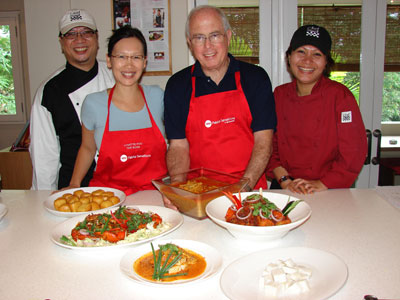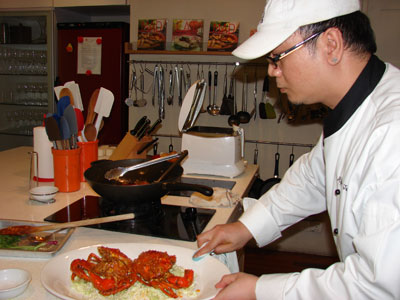What’s Cooking in Singapore? Chili Crab
This item appears on page 63 of the March 2010 issue.
My husband, John, and I have been to Singapore several times. Our son Jim was an exchange student for one semester at the National University of Singapore and often ate at hawker stalls, informal streetside eateries.
Jim said, “A hawker stall was a great place for a filling meal on a limited budget.”
Over the years, the hawker stalls have transformed, just like Singapore. The eateries are now hygienic places with food prepared by licensed staff, but they are still considered places for a good, inexpensive meal.
Food is such an integral part of the Singaporean culture that the local greeting translates as, “Have you eaten?”
On a trip in February ’09, John and I signed up for a cooking lesson at Palate Sensations, Pte., Ltd. (1 Westbourne Road #03-05, Aden, Singapore 138941; phone 64799025, fax 64796285, www.palatesensations.com). (This place was off Portsdown Road and opposite Colonial Bar, with entrance via Whitchurch Road.)
Palate Sensations offers a variety of cooking lessons at various prices, but we were interested in learning how to make Singapore chili crab, the country’s national dish.
In the 1950s Madam Cher Yam Tian and her husband, Mr. Lim Choon Ngee, set up a hawker stall on the seashore. Her specialty was crab in a chili-spiked sauce. Several restaurants have replaced her stall, but the recipe has survived. Today there are many versions of the dish, which combines elements of the Malay and Chinese cultures — integral parts of Singaporean life.
I was impressed with the concern that Chef Alfie Jerome and his wife, Chef Lulu, showed for the live crabs. Chef Lulu explained, “First we place them into the freezer until they go to sleep.” Chef Alfie finished with, “Then we kill them quickly with a knife through the heart.”
Besides covering Singapore chili crab, the three- to four-hour lesson, for US$70, included sayur lodeh, or vegetable in coconut gravy, which is traditionally served for breakfast at the end of Ramadan, the Islamic month of fasting.
salt to taste
½ tbsp soy sauce
4 cups chicken stock
1 egg
½ tsp cornstarch mixed with ¼ cup of water
1 sprig coriander leaf (cilantro)
oil for frying
2 fresh crabs
¼ cup dried shrimp (optional)
2 tbsp grated ginger
1 large red chili, diced (but do not include seeds)
4 cloves minced garlic
1 medium onion, minced
2 tbsp chili sauce
2 tbsp tomato sauce
1 tbsp sugar
1½ cups coconut milk
2 cups water
1½ heads Chinese cabbage, cut in chunks
2 carrots, peeled and julienned
½ turnip, peeled and julienned
4 pieces of bean curd (firm tofu), cut in triangles
15 long beans or green beans
2 pieces tempe (aka tempeh, fermented soya beans) or more tofu
cooking oil
1 tsp chili powder
Spice Paste
Blend the items in this column in a blender:
2 tbsp chili paste
1 tsp belacan (or any shrimp paste) or it can be omitted
2 large red Spanish onions
4 garlic cloves
2 stalks lemongrass
20 small dried shrimp (optional)
1 inch fresh ginger, peeled
1 tsp coriander powder
1 tsp turmeric powder
1 tsp cumin powder


